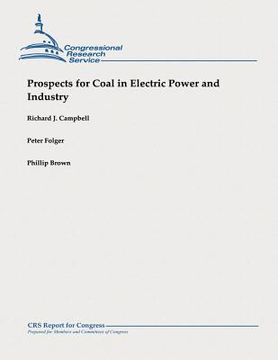Reseña del libro "Prospects for Coal in Electric Power and Industry (en Inglés)"
For most of the twentieth century, the primary use of coal in the United States was for electric power generation, and for most of the history of power generation in the United States, coal has been the dominant fuel used to produce electricity. Even as recently as 2011, coal was the fuel used for almost 42% of power generation in the United States accounting for 93% of coal use. Industrial uses represented the remaining 7%. However, in April 2012, coal's share of the power generation market dropped to about 32% (according to Energy Information Administration statistics), equal to that of natural gas. Coal was the fuel of choice because of its availability and the relatively low cost of producing electricity in large, coal-burning power plants which took advantage of coal's low-priced, high energy content to employ economies of scale in steamelectric production. However, coal use for power generation seems to be on the decline, and the magnitude of coal's role for power generation is in question. Two major reasons are generally seen as being responsible: the expectation of a dramatic rise in natural gas supplies, and the impact of environmental regulations on an aging base of coal-fired power plants. A recent drop in natural gas prices has been enabled by increasing supplies of natural gas largely due to horizontal drilling and hydraulic fracturing (i.e., fracking) of shale gas formations. If the production can be sustained in an environmentally acceptable manner, then a long-term, relatively inexpensive supply of natural gas could result. Decreased natural gas prices are lowering wholesale electricity prices, stimulating a major switch from coal to gas-burning facilities. The electric utility industry values diversity in fuel choice options since reliance on one fuel or technology can leave electricity producers vulnerable to price and supply volatility. However, an "inverse relationship" may be developing for coal vs. natural gas as a power generation choice based on market economics alone, and policies which allow one fuel source to dominate may come at the detriment of the other. Coal-fired power plants are among the largest sources of air pollution in the United States. More than half a dozen separate Clean Air Act programs could possibly be used to control emissions, which makes compliance strategy potentially complicated for utilities and difficult for regulators. Because the cost of the most stringent available controls, for the entire industry, could range into the tens of billions of dollars, some power companies have fought hard and rather successfully to limit or delay regulations affecting them, particularly with respect to plants constructed before the Clean Air Act Amendments of 1970 were passed. The expected retirement of approximately 27 GW of coal-fired capacity by 2016 has been reported to the Energy Information Administration (EIA) by coal plant owners and operators, accounting for approximately 8.5% of U.S. coal-fired capacity. While the costs of compliance with new Environmental Protection Agency regulations are a factor, several other issues are cited by coal plant owners and operators as contributing to these retirement decisions including the age of coal-fired power plants, flat to modest electricity demand growth, the availability of previously underutilized natural gas combined-cycle power plants, and the lower price of natural gas due to shale gas development. Even coal plants which have made significant modifications to meet existing EPA regulations are being closed or mothballed due to a combination of low natural gas prices, and the inability to sell power into other markets. EIA expects coal to be a significant part of the U.S. power generation industry's future to well past 2030. But given price competition from natural gas, and emerging environmental regulations, that role will likely be smaller than in recent decades. Coal-fired generation is likely to face a challenging future.

